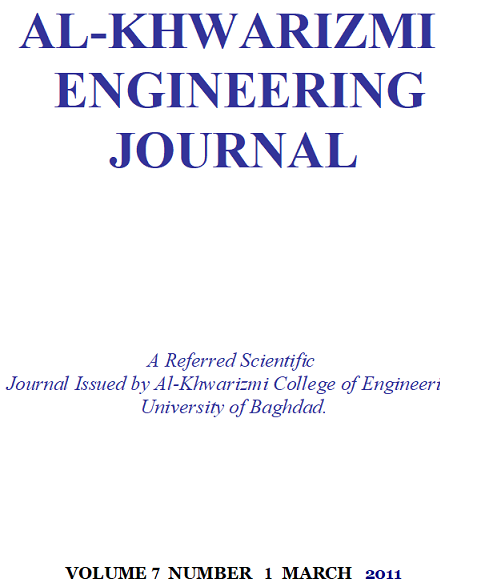A Digital-Based Optimal AVR Design of Synchronous Generator Exciter Using LQR Technique
Abstract
In this paper a new structure for the AVR of the power system exciter is proposed and designed using digital-based LQR. With two weighting matrices R and Q, this method produces an optimal regulator that is used to generate the feedback control law. These matrices are called state and control weighting matrices and are used to balance between the relative importance of the input and the states in the cost function that is being optimized. A sample power system composed of single machine connected to an infinite- bus bar (SMIB) with both a conventional and a proposed Digital AVR (DAVR) is simulated. Evaluation results show that the DAVR damps well the oscillations of the terminal voltage and presents a faster response than that of the conventional AVR.
Downloads
References
[2] Kundur P., “Power System Stability and Control”, McGraw-Hill Inc., 1994.
[3] IEEE Committee Report, “Computer Representation of Excitation Systems”, IEEE Transactions on Power Apparatus and Systems, Vol. Pas-87, No. 6, June 1968.
[4] Rangnekar S., “Development of state-Space and Study of Performance Characteristics of Digital Based Excitation Control System ST4B with Single Machine Connected to Infinite Bus”, IEEE International Conference on Control Applications, Kohala Coast-Island of Hawai'I, Hawai'I, USA, August 22-27, 1999.
[5] Senjyu T., Yamashita T., Uezato K, and Fujita H., “ LMI Approach Based Excitation H∞ Controller Design for Damping of Power System Oscillations and Control of terminal Voltage”, IEEE International Conference on Control Applications, 1999.
[6] Venayagamoorthy G. K. and Harley R. G., “A Continually Online Trained Neurocontroller for Excitation and Turbine Control of a Turbogenerator”, IEEE Transactions on Energy Conversion, Vol. 16, No. 3, September 2001.
[7] Venayagamoorthy G. K. and Harley R. G., “ Two Separate Continually Online-Trained Neurocontrollers for Excitation and Turbine Control of a Turbogenerator”, IEEE Transactions on Industry Applications, Vol. 38, No. 3, May/June 2002.
[8] Mitra, P., Chowdhury S.P., Pal S.K., and Crossley P.A., “Intelligent AVR and PSS with Adaptive hybrid learning algorithm”, IEEE Power and Energy Society General Meeting - Conversion and Delivery of Electrical Energy in the 21st Century, pages:1-7, 2008.
[9] Fusco G. and Russo M., “A Adaptive Voltage Regulator Design for Synchronous Generator”, IEEE Transactions on Energy Conversion, Vol. 23 , Issue 3, pages: 946-956, 2008.
[10] Mohammadi, S. M. A., Gharaveisi A. A., Mashinchi M., and Rafiei S. M. R., “New Evolutionary Methods For Optimal Design Of PID Controllers for AVR System ”, IEEE Conference on Power Tech, pages 1-8, Bucharest, Jun 28-Jul 2, 2009.
[11] Yoshimura S., Iki H., Uriu Y., Anai H., and Hyodo N., “Generator excitation control using a parameter space design method ”,43rd international universities power engineering conference, pages 1-4,Padova, Italy,1-4 September, 2008.
[12] Dysko A., Leithead W. E., O'Reilly J., “Enhanced Power System Stability by Coordinated PSS Design ” IEEE Transactions on Power Systems, pages 413-422, 2010.
[13] Ogata K., “Modern Control Engineering”, Prentice-Hall International, Inc, 1973.
[14] “Control Tutorial for MATLAB and Simulink”, a website: http://www.engin.umich.edu/class/ctms/index.htm
[15] Franklin G. F., Powell J. D., and Workman M. L., “Digital Control of Dynamic Systems”, Adison-Wesley, 3rd Edition, 1998.
[16] Fadali M. S., “Digital Control Engineering: Analysis and Design”, Elsevier Inc, 2009.
[17] Ogata K., “Modern Control Engineering”, 4th edition, Prentice-Hall International, Inc, 2002.
[18] Moudgalya K. M., “Digital Control”, John Wiley & Sons, Ltd, 2007.
[19] “Control System Toolbox”, MATLAB, The MathWorks, Inc, 2009.
[20] Dutton K., Thompson S., and Barraclough B., “The Art of Control Engineering ”, Adison-Wesley,1997.
[21] Law B. E., “Simulation of the transient response of synchronous machines”, B.Sc. thesis, the university of Queensland, School of Information Technology and Electrical Engineering, October, 2001.
[22] Chen S. and Malik O. P., “Power System Stabilizer Design using μ Synthesis”, IEEE Transactions on Energy Conversion, Vol. 10, No. 1, March 1995.
[23] Franklin G. F., Powell J. D., and Workman M. L., “A Robust H∞ Synthesis Controller for Power System Stabilization”,, ASCE Journal, Volume (5), Issue (II), June, 2005.
[24] IEEE Power Engineering Society, “IEEE Recommended Practice for Excitation System Models for Power System Stability Studies”, IEEE Inc., 21 April 2006.
Published
Issue
Section
License
Copyright: Open Access authors retain the copyrights of their papers, and all open access articles are distributed under the terms of the Creative Commons Attribution License, which permits unrestricted use, distribution, and reproduction in any medium, provided that the original work is properly cited. The use of general descriptive names, trade names, trademarks, and so forth in this publication, even if not specifically identified, does not imply that these names are not protected by the relevant laws and regulations. While the advice and information in this journal are believed to be true and accurate on the date of its going to press, neither the authors, the editors, nor the publisher can accept any legal responsibility for any errors or omissions that may be made. The publisher makes no warranty, express or implied, with respect to the material contained herein.












